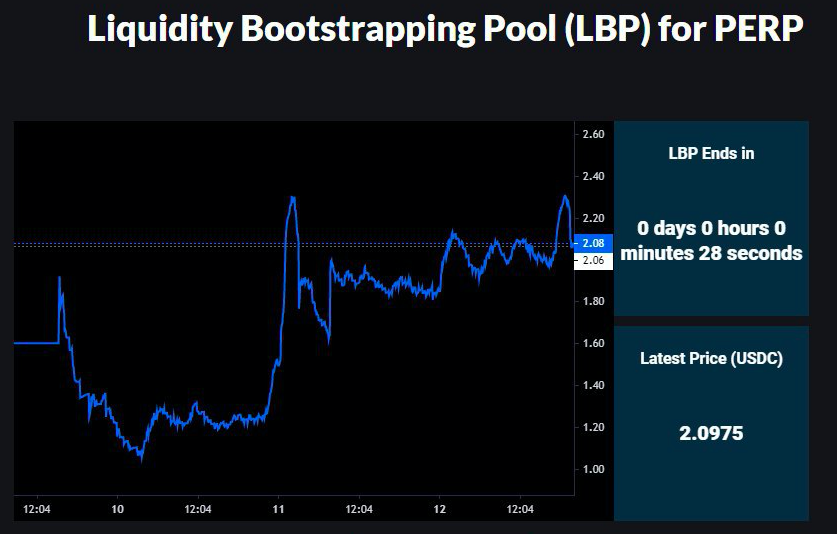Key Takeaways
- Token sales conducted on Uniswap and Mesa were inefficient because frontrunners thrived at the expense of genuine investors.
- Hegic’s sale used a malleable price-supply formula to ensure every investor bought tokens at the same price while eliminating front-running.
- Perpetual Protocol also hindered front-running on their token sale with a dynamically-weighted Balancer pool.
- Future DeFi projects should take a hint from both of these models, as they offer investors substantial benefits.
Share this article
DeFi projects Hegic and Perpetual Protocol helped facilitate a major breakthrough in how permissionless token sales are conducted. Both protocols maximized for fairness and efficiency, offering significant benefits to previous IDO models.
Brief History of DeFi’s IDOs
Initial DEX Offerings (IDOs) aren’t too different from ICOs or IEOs. The critical difference is that an IDO is done using a decentralized exchange (DEX)or through smart contracts. There’s no mediator between the project raising capital and its investors.
The first few IDOs were launched by Compound (COMP), UMA Protocol (UMA), and bZx (BZRX). All three of these offerings were launched on Uniswap and followed a similar pattern: bots got in first, people started to buy up tokens, then the bots dumped on investors.
Once Uniswap was recognized as an inefficient venue to establish a fair price for a token, projects started to look at Mesa, an auction-style DEX. However, Mesa was anything but efficient. Prices were decided fairly using an auction, but the protocol couldn’t handle the number of trades that investors tried to push through.
mStable’s (MTA) IDO was a bit of a disaster because of Mesa’s backend woes, causing investors to wait longer than expected for their orders to clear.
After these events, DeFi protocols have been in search of the perfect method to raise capital in a permissionless way. Hegic and Perpetual Protocol both found solutions.
Hegic’s Initial Bonding Curve Offering
Though technically not an IDO, Hegic’s IBCO captures the essence of permissionless finance. The offering went through without a hitch and offers promise as a capital-raising primitive in DeFi.
The IBCO uses a bonding curve with a multiplier, so the price of the token increases as more investors deposit money to buy it.
One thousand four hundred unique addresses contributed 31,500 ETH to Hegic’s public offering. The IBCO opened at $0.0027 and ended at approximately $0.13. If conducted on Uniswap, this means the first buyer got a price of $0.0027 and the last buyer at $0.13, marking a 4,400% gain.

However, Hegic’s bonding curve settles at one price. Whether one invests first or last, the settlement price was the same $0.13 for everyone. But for a typical ICO or IEO, the listing price is determined beforehand. It doesn’t increase alongside demand. This isn’t ideal because it means the project may leave money on the table.
Bonding curves fix this, allowing price to scale alongside demand. As more investors came in to purchase HEGIC tokens, the price of each token increased. This is precisely what Mesa auctions aspired to do but were unable to.
The IBCO model gave everyone a standard settlement price, irrespective of how early or late they were. It also allowed Hegic to raise capital at a higher price than a centralized platform as it generated more demand.
In the end, it created a win-win scenario for investors and the Hegic team.
Perpetual’s Balancer Liquidity Bootstrapping Pool (LBP)
Another interesting capital-raising primitive emerged via Perpetual Protocol’s use of a Balancer Labs’ pool. Balancer is a flexible AMM that allows assets in a pool to exist with custom weights. This is opposed to Uniswap’s rigid 50-50 weighting structure.
Perpetual wanted to offer tokens in a way that could not be frontrun. To do this, they designed the pool in a way where buying later would result in a lower price.
The pool started as a 90-10 PERP/USDC pool but ended as a 30-70 pool. Every hour, the weight shifted by approximately 0.83%. PERP’s weight in the pool decreased with each mined Ethereum block.
For example, if there is $1,000 in the pool with weights of 90% and 10%, this means there is $900 of PERP and $100 of USDC, implying a price of $9 per PERP. However, the same $1,000 with weights of 30% for PERP and 70% for USDC results in $300 of PERP and $700 of USDC. This scenario implies a price of $0.43 per PERP.
This ensured the token sale started at a higher price and ended at a lower price.
Unlike Hegic, this was more market-oriented and included slightly more complex game theory. The intention behind this model was to limit front-running, but still allow demand to determine the token’s price.
The weight of PERP and USDC in the pool shifted in a way that would reduce the price of PERP, but demand was the most important driver of price. Low demand would result in the pool reducing the price of PERP. But tremendous demand would allow price to increase despite the change in weights.

The chart shows that a subsequent dump met each pump. Presumably, speculators who jumped in early and understood that the pool would inherently suppress price added to the effect by selling their tokens back into the pool.
Every genuine investor had an opportunity to enter within a fair price range. But in the end, demand was overwhelming, so the price suppression didn’t hit as hard as expected.
Future of Fundraising in DeFi
These two concepts are radical improvements to previous IDO models. The general idea was to ensure genuine investors weren’t put at a disadvantage, and this was successful in both cases.
As the DeFi boom takes off, more projects will emerge, and they will hopefully take a cue from Perpetual Protocol and Hegic.
DeFi has been in dire need of a better way to facilitate public token sales, and it may have just found the winning recipe.
Disclosure: One or more members of the Crypto Briefing Management team are investors in Hegic.
Share this article
DeFi Reinvented the ICO, It Flopped: Assessing the IDO
Decentralized exchanges (DEXes) have become a new way for crypto founders to raise capital. While the idea is novel, it’s broken until several major issues are solved. The History of…
Hegic: New Age Options Trading Protocol
Hegic is an options trading protocol built on the Ethereum blockchain. Users can buy or sell call and put options using Hegic. It is entirely on-chain, permissionless, and non-custodial –…
Understanding Position Sizing
Let’s briefly examine the most important aspect of any trading system, position sizing, or specifically how much we will bet on any one given trading idea.
Aave Protocol’s New Product Takes on $300 Billion P2P Loan Marke…
Aave Protocol’s newest product, credit delegation, allows users to take collateral-free loans using DeFi. This service has the potential to disrupt the $300 billion P2P lending market. However, unlike Aave’s money…


